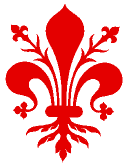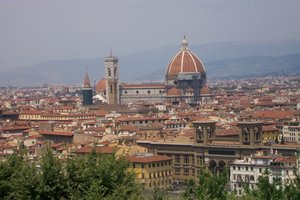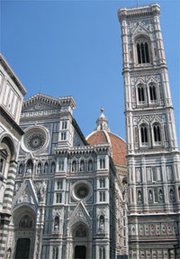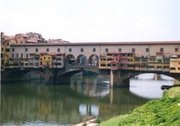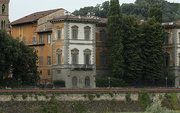Florence
|
|
Florence (Italian, Firenze) is a city in the center of Tuscany, in central Italy.The city on the Arno River has a population of around 400,000, plus a suburban population in excess of 200,000. Florence is the capital of the region of Tuscany and briefly (1865-1871) the capital of the kingdom of Italy. Florence was long ruled (1434-1494, 1512-1527 and 1530-1737) by the Medici family.
A centre of medieval European trade and finance, the city is sometimes considered the birthplace of the Italian Renaissance. Florence is famous for its wealth of fine art and architecture.
Florence_bridges.jpg
| Contents |
History of Florence
Main article: History of Florence
Florence's recorded history began with the establishment in 59 BC of a settlement ("Florentia") for Roman veterans. The seat of a bishopric from around the beginning of the 4th century A.D., the city experienced subsequent periods of Byzantine, Ostrogothic, Lombard and Frankish rule, during which the population may have fallen to as few as 1,000.
Reviving from the 10th century and governed from 1115 by an autonomous commune, the city was plunged into internal strife by the 13th-century struggle between the Ghibellines, supporters of the German emperor, and the pro-Papal Guelphs, who after their victory split in turn into feuding "White" and "Black" factions led respectively by Vieri de Cerchi and Corso Donati. (See Guelphs and Ghibellines.) These struggles eventually led to the exile of the White Guelphs, one of whom was Dante Alighieri. This factional strife was later recorded by the White Guelph Dino Compagni in his Chronicles of Florence.
Political conflict did not, however, prevent the city's rise to become one of the most powerful and prosperous in Europe, assisted by her own strong gold currency, the florin (introduced in 1252), the eclipse of her formerly powerful rival Pisa (defeated by Genoa in 1284 and subjugated by Florence in 1406), and the exercise of power by the mercantile elite following an anti-aristocratic movement, led by Giano della Bella, that resulted in a set of laws called the Ordinances of Justice (1293).
Of a population estimated at 80,000 before the Black Death of 1348, 25,000 are said to have been supported by the city's woollen industry: in 1345 Florence was the scene of an attempted strike by wool combers (ciompi), who in 1378 rose up in a brief revolt against oligarchic rule in the Revolt of the Ciompi. After their suppression, the city came under the sway (1382-1434) of the Albizzi family, bitter rivals of the Medici. Cosimo de' Medici was the first Medici family member to essentially control the city from behind the scenes, his power coming from a vast patronage network and his alliance to the new immigrants, the gente nuova. The fact that the Medici were bankers to the pope also didn't hurt. Cosimo was succeeded by his son Piero, who was shortly thereafter succeeded by Cosimo's grandson, Lorenzo in 1469. Lorenzo was a great patron of the arts, commissioning works by Michelangelo, Leonardo da Vinci and Botticelli.
After Lorenzo's death in 1492 and his son Piero's exile in 1494, the first period of Medici rule ended with the restoration of a republican government, influenced until his execution (1498) by the teachings of the radical Dominican prior Girolamo Savonarola, whose monomaniacal persecution of the widespread Florentine sodomy and of other worldly pleasures foreshadowed many of the wider religious controversies of the following centuries.
A second individual of unusual insight was Niccolchiavelli, whose prescriptions for Florence's regeneration under strong leadership have often been seen as a legitimisation of political expediency and even malpractice. Commissioned by the Medici, Machiavelli also wrote the Florentine Histories, the history of the city. Florentines drove out the Medici for a second time and re-established a republic on May 16, 1527. Restored twice with the support of both Emperor and Pope, the Medici in 1537 became hereditary dukes of Florence, and in 1569 Grand Dukes of Tuscany, ruling for two centuries. Only Republic of Lucca (later a Duchy) was independent from Florence in all Tuscany.
The extinction of the Medici line and the accession in 1737 of Francis Stephen, duke of Lorraine and husband of Maria Theresa of Austria, led to Tuscany's inclusion in the territories of the Austrian crown. Austrian rule was to end in defeat at the hands of France and the kingdom of Sardinia-Piedmont in 1859, and Tuscany became a province of the united kingdom of Italy in 1861.
Florence replaced Turin as Italy's capital in 1865, hosting the country's first parliament, but was superseded by Rome six years later following the latter's addition to the kingdom. After doubling during the 19th century, Florence's population tripled in the 20th with the growth of tourism, trade, financial services and industry. During World War II the city experienced a year-long German occupation (1943-1944). The Allied soldiers who died driving the Germans from Tuscany are buried in cemeteries outside the city (Americans about 6 miles south of the city [1] (http://www.asgdd.it//amevceme.htm), British and Commonwealth soldiers a few miles East of the center on the North bank of the Arno[2] (http://www.veteransagency.mod.uk/remembrance/remembrance_cwgc6.htm))
In November 1966 the Arno flooded parts of the centre, damaging many art treasures. There was no warning from the authorities who knew the flood was coming, except a phone call to the jewellers on the Ponte Vecchio.
Florence and the Renaissance
The surge in artistic, literary and scientific investigation that occurred in Florence in the 14th-16th centuries was precipitated by Florentines' preoccupation with money and with the display of wealth and leisure.
Added to this, the crises of the Catholic church (especially the controversy over the French Avignon Papacy and the Great Schism) along with the catastrophic effects of the Black Death were to lead to a re-evaluation of medieval values, resultant in a revisitation of those of classical antiquity. Florence benefited materially and culturally from this sea-change in social consciousness.
A tour of Florence
At the heart of the city is the Fountain of Neptune, which is a masterpiece of marble sculpture at the terminus of a still functioning Roman aqueduct. The Arno river, which cuts through the old part of the city, is as much a character in Florentine history as many of the men who lived there. Historically, the locals have had a love-hate relationship with the Arno -- which alternated from nourishing the city with commerce, and destroying it by flood. Many of the bridges across the Arno were built by the Romans.
One of the bridges in particular, however, stands out as being unique -- The Ponte Vecchio, whose most striking feature is the multitude of shops built on it. First constructed by the Etruscans in ancient times, this bridge is the only one in the city to have survived World War II intact.
The most famous palace in the city is San Lorenzo, which has become a monument to the Medici family who were one of the most powerful families in Florence during the 15th century. Nearby is the Uffizi Gallery, one of the very finest art galleries in the world.
The Uffizi itself is located on the corner of Piazza della Signoria, a site important for three main reasons:
- In 1301, it was where Dante was sent into Exile (a plaque on one of the walls of the Uffizi commemorates the event).
- In 1497, it was the location of the Bonfire of the Vanities (a plaque in the middle of the plaza commemorates that event), followed in 1498 by the execution of its its instigator, Girolamo Savonarola
- In 1504, ot was the original location of Michelangelo's David (now replaced by a reproduction), in front of the Palazzo della Signoria (aka Palazzo Vecchio).
In addition to the Uffizi, Florence has other museums which would be the premier art collection of almost any other major city in the world:
The Bargello concentrates on sculpture, containing many priceless works of art created by such sculptors as Donatello, Giambologna, and Michelangelo.
The Accademia dell' Arte del Disegno (often simply called the Accademia) collection's highlights are Michelangelo's David and his Slaves.
Across the Arno is the huge Pitti Palace lavishly decorated with the Medici family's former private collection. Adjoining the Palace are the Boboli Gardens, elaborately landscaped and with many interesting sculptures.
The elaborate Santa Croce church contains the monumental tombs of Galileo, Michelangelo, Dante, and many other notables.
The crowning architectural jewel of Florence is the domed cathedral of the city, Santa Maria del Fiore, known as "The Duomo". The magnificent dome was built by Filippo Brunelleschi. The nearby Campanile Tower (by Giotto) and the Baptistery buildings are also highlights.
Other important sites in Florence include the church of Santa Maria Novella and the Orsanmichele.
The city's principal football team is ACF Fiorentina.
Florence has been the setting for numerous works of fiction and movies, including the novel and film Hannibal.
Notable people from the city
- Dante Alighieri
- Lorenzo de Medici
- Cosimo de Medici
- Michelangelo
- Girolamo Savonarola
- Niccolchiavelli
- Francesco Guicciardini
- Baccio D'Agnolo
- Marco Masini
- Franco Zeffirelli
- Florence Nightingale
- Oriana Fallaci
- Countess de Castiglione
Administration
- Mayor: Leonardo Domenici, elected June 13, 1999

